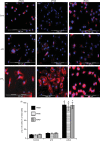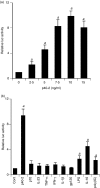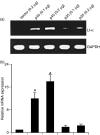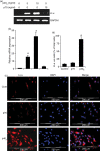Induction of lymphotoxin-alpha by interleukin-12 p40 homodimer, the so-called biologically inactive molecule, but not IL-12 p70
- PMID: 19019087
- PMCID: PMC2712100
- DOI: 10.1111/j.1365-2567.2008.02985.x
Induction of lymphotoxin-alpha by interleukin-12 p40 homodimer, the so-called biologically inactive molecule, but not IL-12 p70
Abstract
Interleukin-12 (IL-12) p70 (p40:p35) is a bioactive cytokine and its biological functions are becoming clear. On the other hand, the IL-12 p40 homodimer (p40(2)) was considered an inactive or inhibitory molecule and its functions are poorly understood. It has been reported that increased expression of lymphotoxin-alpha (Lt-alpha) in the central nervous system as well as in peripheral immune cells is associated with multiple sclerosis and experimental allergic encephalomyelitis. Here we describe that p40(2) induces the expression of Lt-alpha in primary mouse and human microglia, BV-2 microglial cells, splenic macrophages, RAW 264.7 cells and splenic T cells. Interestingly, IL-12 p70 was either unable to induce Lt-alpha or was a very weak inducer of Lt-alpha in these cell types. Consistently, p40(2), but not p70, induced Lt-alpha promoter-driven luciferase activity in microglial cells. Among various stimuli tested, p40(2) emerged as the most potent followed by IL-16, lipopolyaccharide and double-stranded RNA in inducing the activation of Lt-alpha promoter in microglial cells. Furthermore, an increase in Lt-alpha messenger RNA expression by overexpression of p40, but not p35, complementary DNA and induction of Lt-alpha expression by p40(2) in microglia isolated from IL-12p35(-/-) mice confirm that p40, but not p35, is responsible for the induction of Lt-alpha. Finally, by using primary microglia from IUL-12 receptor beta1 deficient (IL-12Rbeta1(-/-)) and IL-12Rbeta2(-/-) mice, we demonstrate that p40(2) induced the expression of Lt-alpha in microglia and macrophages via IL-12Rbeta1, but not IL-12Rbeta2. These studies delineate a novel biological function of p40(2) that is absent in IL-12.
Figures







Similar articles
-
Interleukin-12 (IL-12), but not IL-23, induces the expression of IL-7 in microglia and macrophages: implications for multiple sclerosis.Immunology. 2014 Apr;141(4):549-63. doi: 10.1111/imm.12214. Immunology. 2014. PMID: 24224652 Free PMC article.
-
IL-12 p40 homodimer, but not IL-12 p70, induces the expression of IL-16 in microglia and macrophages.Mol Immunol. 2009 Feb;46(5):773-83. doi: 10.1016/j.molimm.2008.10.033. Epub 2008 Dec 18. Mol Immunol. 2009. PMID: 19100623 Free PMC article.
-
Induction of IL-2 by interleukin-12 p40 homodimer and IL-12, but not IL-23, in microglia and macrophages: Implications for multiple sclerosis.Cytokine. 2024 Feb;174:156457. doi: 10.1016/j.cyto.2023.156457. Epub 2023 Dec 5. Cytokine. 2024. PMID: 38056248 Free PMC article.
-
Exhaustive exercise and type-1/type-2 cytokine balance with special focus on interleukin-12 p40/p70.Exerc Immunol Rev. 2003;9:48-57. Exerc Immunol Rev. 2003. PMID: 14686094 Review.
-
IL-12: the role of p40 versus p75.Scand J Immunol. 2002 Jul;56(1):1-11. doi: 10.1046/j.1365-3083.2002.01101.x. Scand J Immunol. 2002. PMID: 12100467 Review.
Cited by
-
Cerebrospinal fluid IL-12p40, CXCL13 and IL-8 as a combinatorial biomarker of active intrathecal inflammation.PLoS One. 2012;7(11):e48370. doi: 10.1371/journal.pone.0048370. Epub 2012 Nov 30. PLoS One. 2012. PMID: 23226202 Free PMC article.
-
Role of cytokines as mediators and regulators of microglial activity in inflammatory demyelination of the CNS.Neuromolecular Med. 2010 Jun;12(2):99-132. doi: 10.1007/s12017-010-8112-z. Epub 2010 Mar 30. Neuromolecular Med. 2010. PMID: 20411441 Review.
-
Calpain mediated expansion of CD4+ cytotoxic T cells in rodent models of Parkinson's disease.Exp Neurol. 2020 Aug;330:113315. doi: 10.1016/j.expneurol.2020.113315. Epub 2020 Apr 14. Exp Neurol. 2020. PMID: 32302678 Free PMC article.
-
IL-23 p19 knockout mice exhibit minimal defects in responses to primary and secondary infection with Francisella tularensis LVS.PLoS One. 2014 Oct 8;9(10):e109898. doi: 10.1371/journal.pone.0109898. eCollection 2014. PLoS One. 2014. PMID: 25296161 Free PMC article.
-
Dendrimer-mediated delivery of N-acetyl cysteine to microglia in a mouse model of Rett syndrome.J Neuroinflammation. 2017 Dec 19;14(1):252. doi: 10.1186/s12974-017-1004-5. J Neuroinflammation. 2017. PMID: 29258545 Free PMC article.
References
-
- Crowe PD, VanArsdale TL, Walter BN, et al. A lymphotoxin-beta-specific receptor. Science. 1994;264:707–10. - PubMed
-
- Cannella B, Sizing ID, Benjamin CD, Browning JL, Raine CS. Antibodies to lymphotoxin alpha (LT alpha) and LT beta recognize different glial cell types in the central nervous system. J Neuroimmunol. 1997;78:172–9. - PubMed
-
- Matusevicius D, Navikas V, Soderstrom M, Xiao BG, Haglund M, Fredrikson S, Link H. Multiple sclerosis: the proinflammatory cytokines lymphotoxin-alpha and tumour necrosis factor-alpha are upregulated in cerebrospinal fluid mononuclear cells. J Neuroimmunol. 1996;66:115–23. - PubMed
-
- Navikas V, He B, Link J, et al. Augmented expression of tumour necrosis factor-alpha and lymphotoxin in mononuclear cells in multiple sclerosis and optic neuritis. Brain. 1996;119(Pt 1):213–23. - PubMed
Publication types
MeSH terms
Substances
Grants and funding
LinkOut - more resources
Full Text Sources
Other Literature Sources
Molecular Biology Databases
Research Materials
Miscellaneous

